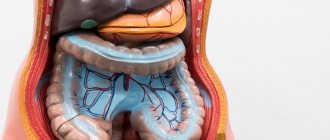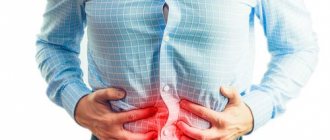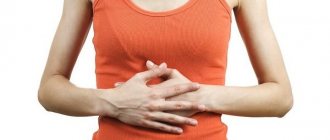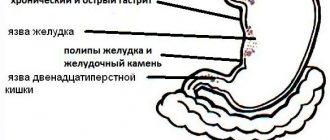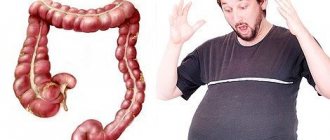Main causes of nausea and abdominal pain
We can say with confidence that such unpleasant symptoms as abdominal pain and nausea have been experienced by every person at least once in their life.
There are a huge number of reasons for this condition, but most often, when the stomach hurts and feels nauseous, this indicates food intoxication. In addition, the stomach almost always hurts and nausea occurs if there are problems with the gastrointestinal tract. Additional symptoms may include heartburn, rumbling in the stomach, and increased gas production.
Among the main reasons are the following diseases:
- gastritis;
- pancreatitis;
- pathologies of the biliary tract;
- kidney and liver diseases;
- oncological formations.
Important!
Severe abdominal pain accompanied by nausea occurs during an acute attack of appendicitis. In this case, it is very important not to confuse a dangerous pathology with an upset stomach or poisoning and provide timely assistance.
Abdominal pain accompanied by nausea and vomiting may also be associated with the following pathologies:
- With the development of myocardial infarction
. An additional symptom is that the pain radiates to the left shoulder, and this should be a serious reason for an urgent examination. - With food intolerance to certain foods
. In this case, the body refuses to digest certain foods normally. This is usually accompanied by increased gas formation, diarrhea and severe weakness. - Infected with intestinal parasites
. The reason for this is non-compliance with hygiene rules, as well as the consumption of low-quality water and products.
Not often, but still, abdominal pain and nausea may not be associated with pathology of the digestive system.
For example, symptoms may be caused by:
- Orthopedic deviations when there are problems with the spine.
- Stressful conditions that negatively affect the state of the digestive organ.
Women often have stomach pain and nausea during menstruation, as well as with various diseases of the reproductive system. During pregnancy, this condition indicates the development of toxicosis. In this case, it is imperative to inform the doctor about the manifestation of such symptoms.
Treatment
After diagnosis comes treatment. For nausea and pain, use traditional medicine, folk methods, and change your diet.
Medication
Prescription of medications occurs through a specialist. It is not recommended to self-medicate or take painkillers. Painkillers do not eliminate the problem, but only aggravate it and greatly complicate further diagnosis.
After diagnosing the patient and carrying out additional procedures, the doctor prescribes drugs belonging to different categories. Depending on the disease, certain medications are prescribed.
Ranitidine and Phosphalugel are prescribed to regulate stomach acidity. Mostly prescribed in the presence of ulcers and other gastroenterological diseases. Antispasmodics include No-shpu, Papazol - they help relax the gastric muscles.
Enzyme preparations such as Mezim and Festal will help eliminate secretory insufficiency and start the stomach. They are used as a remedy for constipation and flatulence. You can improve intestinal and stomach motility with Motilium and Motilak. Women during toxicosis will be helped by Essentiale with No-shpa.
In case of food poisoning, take activated charcoal. Can be given to a child. The dose is calculated based on body weight.
Traditional methods
Alternative medicine methods can be used for nausea and mild poisoning. Before using this method, you should consult a specialist.
In case of nausea and vomiting caused by poisoning, you need to rinse your stomach. To do this, you should drink a weak solution with potassium permanganate and induce vomiting. If the field of this symptomatic set has stopped: the patient has become without nausea, without pain, it is necessary to restore the water balance.
Decoctions of calendula, chamomile, and mint help with nausea. Water with lemon and honey is considered effective. I also drink ginger tea and rosehip infusion.
Nutrition has a special influence on recovery. The food consumed could cause unpleasant symptoms or poisoning. Therefore, choosing the right food is the key to recovery. Fractional meals are what will help you recover faster.
The patient will have to eat steamed cooked food, soups, and boiled mashed potatoes. Lactic acid products and soft-boiled eggs have a beneficial effect on the stomach. From weaknesses, you can make fruit jelly, marshmallows, and cook jelly for yourself.
During treatment, you should exclude alcohol, soda, rich foods, pickled vegetables, sour, spicy and fatty foods. Strong tea and coffee should also be excluded.
To restore the gastrointestinal tract, you need to eat food in small portions, but increase the number of meals. The stomach should not be full. Give preference to mushy foods.
Special nutrition after illness is developed by a specialist. The approximate duration of the diet is a couple of months. The list proposed above is universal, but dietary nutrition in the case of a specific disease is prepared individually. If you have problems with the gastrointestinal tract, it is worth remembering that fresh vegetables and berries are contraindicated due to the fact that they irritate the intestinal mucosa.
The patient's diet should consist of fresh foods. The exception is fresh bread, which, like fresh vegetables and berries, irritates the mucous membrane.
A very unpleasant sensation during simultaneous pain in the head and stomach, as well as increased body temperature, nausea, dizziness and heaviness in the stomach, is known to most people.
What is the right thing to do when these symptoms appear and what to do?
If you experience pain in the head and painful sensations in the abdomen, do you need to urgently go to the hospital to see a doctor, or is it possible to solve this problem without the help of a specialist?
If you have a headache, stomach pain, nausea and vomiting, it is better not to hesitate to see a doctor. Even in the case of mild poisoning, PMS or toxicosis, consultation with a specialist will not be superfluous. Your healthcare provider will tell you how best to relieve your symptoms, prevent them from recurring, and make sure there are no complications. Situations when symptoms appear systematically or do not respond to therapy deserve special attention.
The persistence of symptoms for 2-3 days or their intensification, despite the actions taken, is an indication for seeking medical help. If the symptoms are vague and there are no signs of disturbance in the general condition, the necessary treatment can be carried out by a general practitioner from a local clinic.
In some cases, trying to get rid of pain with pills can make the situation worse. For example, taking analgesics against the background of appendicitis will not allow the doctor to quickly make the correct diagnosis. The use of folk remedies by cancer patients increases the risk of faster tumor growth. Drugs from the NSAID group have a negative effect on the gastric mucosa, which is extremely dangerous for gastritis.
Permissible manipulations if the above conditions are suspected:
- signs of food poisoning - if the symptoms are not very pronounced, you should rinse the stomach, give an enema, or you can drink activated charcoal or another enterosorbent;
- stomach flu or rotavirus - in adults, in most cases, the disease goes away on its own. To speed up recovery, you need to temporarily stop eating fermented milk products, take activated charcoal to cleanse the intestines and Regidron solution to restore electrolyte balance;
- gastritis - diet, proper nutrition and taking medications that coat the mucous membrane will help;
- toxicosis - eating sour fruits and avoiding fried foods in favor of steamed ones will get rid of it. Additionally, you can take valerian or Cerucal. A head massage will relieve headaches;
- PMS - if severe pain occurs, it is allowed to take antispasmodics or analgesics. To combat persistent cephalalgia, vinegar compresses, drinking lemon balm and mint tea, and rubbing the temples with menthol oil are used.
After eliminating the list of symptoms, it is necessary to reconsider your lifestyle, otherwise the problems may return. It is worth undergoing a full medical examination, which will identify potential risks and help you choose the best option for preventing exacerbations.
If your head and stomach hurt, nausea and vomiting appear, and the causes of the phenomenon are not obvious, you should not carry out independent symptomatic therapy. There is a high probability that it will not give the desired result or will even worsen the situation. A timely visit to a doctor can not only relieve unpleasant symptoms, but also prevent the development of an emergency condition.
Stomach pain and nausea can be relieved in several ways, namely:
- taking medications;
- diet therapy;
- physiotherapeutic procedures;
- use of traditional medicine;
- surgical intervention - this method of therapy is used only if conservative treatment methods are ineffective or for individual indications.
You can get rid of stomach pain and nausea by taking the following medications:
- antacids aimed at normalizing the acidity of gastric juice;
- antispasmodics - to relax the smooth muscles of the stomach;
- enzyme drugs;
- substances to improve the motility of this organ.
Treatment with diet is prescribed by the attending physician personally for each patient. Only a gastroenterologist can:
- compile a complete list of permitted and prohibited products;
- determine the duration of adherence to a gentle diet;
- provide recommendations regarding the preparation, mode and frequency of consumption of dishes;
- introduce new ingredients to the menu.
In addition, you can use traditional medicine recipes, but only after consulting your doctor, otherwise there is a possibility of worsening the illness that caused the main symptoms.
Every person should know the danger signs and the algorithm of actions in case of their occurrence.
So, if the following symptoms appear, you should immediately call an ambulance:
- constant general malaise;
- the appearance of blood impurities in stool and vomit;
- significant increase in temperature;
- irradiation of pain in the lower back - very dangerous for pregnant women;
- loss of consciousness.
Before the doctors arrive, it is strictly prohibited:
- place a heating pad or other warm objects on your stomach;
- take painkillers;
- rub the place where the pain is localized.
At the same time, first aid rules provide for:
- occupying a horizontal position;
- liberation from narrow and tight clothing;
- ensuring a flow of fresh air;
- fractional drinking of still mineral water.
Associated symptoms indicating the disease
The development of a certain pathology can be roughly determined by the accompanying symptoms, but it should be understood that the final diagnosis can be made only after examination.
Stomach pain and vomiting
Abdominal pain, which is accompanied by vomiting, always indicates the development of an inflammatory or infectious process. Such symptoms indicate that the human body is trying to remove toxins, and the reasons for this can be very diverse.
Main reasons:
- Food poisoning
. An additional symptom may be increased body temperature. - Liver diseases
. In this case, the pain syndrome is localized in the area of the gallbladder (right hypochondrium). - Appendicitis
. It is very important to recognize this pathology in a timely manner, otherwise it poses a threat to life. The most common location of pain is the lower abdomen. - Strangulated hernia
. In this case, the pain covers the entire abdominal cavity, which makes diagnosis much more difficult. - Exacerbation of stomach ulcers
. This pathology may be accompanied by diarrhea or constipation.
Lower abdomen hurts
When the lower abdomen hurts, it is caused by various diseases of the abdominal cavity. Pain in this localization may occur due to the formation of kidney stones. This pain is very excruciating, it radiates to the back area. In severe cases, the pain syndrome is accompanied by chills and nausea, and blood often appears in the urine.
Other pathologies that cause pain in the lower abdomen:
- Irritable bowel syndrome
a. In this case, spasmodic pain occurs, increased gas formation is observed, as well as alternating constipation and diarrhea. - Appendicitis
. Such pain can be observed for a long time, but under certain circumstances an exacerbation may occur, which requires urgent medical intervention. - Ulcerative colitis
, which is associated with the appearance of ulcers on the walls of the colon and rectum. Along with severe pain, fatigue and weight loss are always observed, and bloody diarrhea appears over time. - Urinary tract infection
. Such diseases are very often observed in women. - Mesenteric adenitis
, which is characterized by inflammation of the glands on the walls of the small intestine as a result of viral infection.
My head is spinning
Cephalgia (headache) and dizziness with abdominal pain can develop due to the fact that acute pain syndrome provokes cerebral vascular spasm. As a result, hypoxia occurs. As a rule, dizziness begins suddenly, the reasons for this can be serious pathologies, such as: perforated ulcer, acute pancreatitis, renal colic, acute cholecystitis, cholelithiasis.
In addition, the stomach and head can hurt at the same time due to allergic manifestations of premenstrual syndrome in women, nervous strain and stress, or increased physical activity.
Diarrhea (diarrhea)
A combination of symptoms such as abdominal pain and diarrhea is most often a sign of poisoning.
In this case, it may be caused by:
- Chemicals that are part of various detergents, paints and solvents, and sometimes even medications.
- Viruses and bacteria, after infection with which manifestations of intoxication are observed.
- Poor quality food.
In addition, various inflammatory processes can cause diarrhea and abdominal pain. Against this background, serious diseases such as colitis, enteritis, and appendicitis develop.
Abdominal pain in the navel area
The most likely cause of pain in the navel area is an inflammatory process. In addition, pain can be localized in this place when pathologies occur in the kidneys, stomach or ureters.
Among the serious diseases that can cause pain near the navel are the following pathologies:
- Omphalitis.
- Neoplasms of a benign or malignant nature.
- Enterocolitis, which is characterized by spasmodic pain.
- Umbilical hernia, the pain intensifies with increased load.
- Irritable bowel syndrome.
Temperature
Abdominal pain, which is accompanied by elevated temperature, most often indicates an exacerbation of chronic pathologies.
This can occur in the presence of: intestinal obstruction, cholecystitis, pancreatitis, appendicitis, hernia.
The same symptoms in the acute nature of the pain syndrome may indicate complications of various pathological processes, such as:
- Perforation of the gallbladder.
- Perforation of a stomach or duodenal ulcer.
- Rupture of the liver or spleen due to trauma.
- Intestinal bleeding.
Headache
When a headache occurs against the background of pain in the abdomen, this most often indicates poisoning with food, chemicals or medications. Another common cause is infection with rotavirus infection. In this case, a severe headache occurs, which is not relieved by any medications, and a little later gastrointestinal disorders appear, including a stomach ache.
A person also often has a headache when he is diagnosed with gastritis. In the presence of such a pathology, the symptoms are associated with non-compliance with the diet. Staphylococcal infections can also cause headaches, but in this case there are always additional signs of intoxication.
Back hurts
Back and abdominal pain can occur simultaneously with the following pathologies:
- stomach and duodenal ulcers;
- acute pancreatitis;
- hepatic or renal colic;
- gastritis;
- myocardial infarction;
- intestinal obstruction;
- appendicitis.
In women, such symptoms can be observed due to complications of pregnancy or diseases of the genitourinary system.
Diagnostics
Based on symptoms alone, it is impossible to identify the reasons why your stomach hurts and feels sick at the same time. It follows from this that establishing the correct diagnosis requires an integrated approach and includes:
- a detailed survey of the patient plays an important role, since information about the nature and intensity of the manifestation of concomitant symptoms, for example, heartburn, fever, weakness and stool disorders in some cases may indicate a particular ailment;
- familiarizing the clinician with the patient’s medical history and life history;
- performing a thorough objective examination;
- laboratory studies of blood, urine and feces;
- Ultrasound of the abdominal organs;
- FEGDS - to study the inner surface of the esophagus, stomach and duodenum;
- radiography, sometimes the use of a contrast agent may be necessary;
- MRI – to obtain a more detailed structure of internal organs.
Only after studying the results of all examinations will the gastroenterologist decide what to do to eliminate the symptoms in a particular patient.
Treatment is prescribed after a complete diagnosis of the patient. The first stage of diagnosis involves a conversation. As a result of a conversation with the patient, the doctor is engaged in finding out the cause that provoked disturbances in the body, manifested by an unpleasant set of symptoms. The specialist asks about the localization of pain, time of day, frequency, what the patient did and consumed the day before.
The second stage is inspection. By external signs it is possible to identify certain types of disease. If necessary, the patient is subjected to an instrumental examination, including colonoscopy and FGDS. Ultrasound examination is used for suspected neoplasms of various types.
The choice of treatment depends on the examination, individual characteristics, and needs of the person. The severity and stage of the disease makes a decisive difference in the treatment of the patient.
Abdominal pain and nausea common in women
Abdominal pain and nausea in women often occur against the background of the development of diseases of the genitourinary system, but it should be understood that very often inflammation can occur elsewhere, but radiate to the lower abdomen. This is why doctors always palpate various areas of the abdomen to find the source of pain.
Period
Pain during menstruation usually occurs in young girls due to hormonal changes. This is considered normal, but when pain accompanies menstruation in older women, this may indicate the development of pathologies of the reproductive system.
Pregnancy
Pain during pregnancy may indicate a threat of involuntary abortion, so you must inform your doctor about it. But there is no need to worry prematurely, because very often pain during pregnancy is associated with hormonal changes and increased stress.
Diseases of the female pelvic organs
Any pathology of the pelvic organs in women is always accompanied by pain in the abdomen. The most common provoking factor is the inflammatory process that affects the fallopian tubes and ovaries.
Prevention
To prevent people from having problems with stomach pain and nausea, it is necessary:
- completely give up addictions;
- eat properly and balanced;
- avoid physical and emotional stress;
- eat only high-quality products;
- visit an obstetrician-gynecologist at the slightest change in health - this rule applies only to pregnant women;
- take medications in accordance with all doctor’s recommendations;
- sleep enough time.
Since there are no specific preventive measures to prevent the occurrence of such symptoms, it is best to undergo regular preventive medical examinations.
This is a very bad sign when the patient has pain in the head area. If this pain is observed in combination with abdominal cramps, the suffering only intensifies.
Sometimes the problems are unrelated and require separate treatment, but often they arise due to the development of the same disease.
Some reasons that may cause both nausea and headache and stomach heaviness include viruses, premenstrual syndrome, pregnancy, stress, and side effects from certain medications.
It is always necessary to consult with your doctor, who will prescribe the best treatment at home and confirm that no further medical attention is required.
Is treatment possible at home? You can drink herbal tea. Some teas, especially mint and chamomile, have special beneficial properties, they soothe both headaches and intra-abdominal cramps.
There is an option to use compresses. Warm compresses soothe both abdominal cramps and headaches.
It is recommended to lie on your back in a dark room and place a heating pad or warm cloths on your stomach and head. Alternating hot and cold compresses on the head and neck can also be effective.
Headache and nausea can also be treated with medications. If a person suspects their pain is caused by stress or tension, it is recommended to take Acetaminophen, which does not upset the stomach.
It is advisable to eat foods that soothe the stomach. Abdominal pain that causes cramps and spasms usually indicates that the cause is not serious.
Pain may indicate excess gas in the stomach. The best foods to prevent this condition include:
- low-fat dairy products;
- applesauce;
- rice;
- crackers.
It is recommended to look for other symptoms or signs that will help the person determine the causes of the headache and abdominal discomfort.
If they are accompanied by fever, vomiting or diarrhea, the patient may develop viral gastroenteritis.
Tracking your menstrual cycle will often indicate to a woman whether PMS is causing similar symptoms.
If a woman is taking hormone therapy, cramps and headaches can sometimes be side effects.
It is worth seeking advice from a medical professional if a woman suspects she is pregnant or has a serious illness, including a bacterial or parasitic infection such as toxoplasmosis.
It is especially important to seek medical help if a person already has a serious disease process that undermines the immune system and overall health, since a secondary disease can pose an even greater threat.
A highly qualified doctor will determine the reasons for the appearance of certain symptoms in a sick person and tell you what to do in a given situation (how to treat a specific illness).
What to do if your stomach hurts and you feel sick
When your stomach hurts severely and you feel nauseous without any explainable reason, you must definitely call an ambulance.
The main causes of severe pain requiring urgent medical attention:
- Acute appendicitis.
- Food poisoning.
- Acute cholecystitis.
- Exacerbation of gynecological pathology in women.
- Acute pancreatitis.
- Exacerbation of peptic ulcer disease.
- Ulcerative colitis.
First time stomach pain
If your stomach hurts for the first time, but the pain is not acute, but mild, then you should not wait for a second attack. It is imperative to consult a doctor, who will definitely prescribe an examination. It is important to understand that many serious diseases signal their development by abdominal pain, which is accompanied by nausea. And treatment will always be successful at the initial stage.
Constant stomach pain and nausea
Most often, constant stomach pain and nausea occur with the development of gastritis. If the disease is not diagnosed, then the person does not follow a diet, and food constantly irritates the inflamed mucous membrane. If you do not undergo examinations to confirm the diagnosis and do not begin treatment, this can lead to dangerous consequences for health, and sometimes even life.
The stomach may constantly hurt due to a feeling of nausea if there are problems with the digestive system. Very often, such symptoms accompany irritable bowel syndrome. Any gastrointestinal pathology requires adherence to a diet and proper treatment.
After sex
Pain and nausea after sex can occur not only for physiological reasons, but also for psychological ones. This can only be determined after a full examination. In women, such symptoms very often indicate the presence of a tumor in one of the organs of the reproductive system. Such a pathology can be suspected if pain constantly occurs in the same place.
After meal
Pain in the abdomen after eating, accompanied by nausea, is almost always associated with gastrointestinal pathologies. But they can also occur due to banal overeating or intolerance to certain foods. Quite often, adjusting your diet in accordance with your doctor’s recommendations allows you to get rid of them.
Classification
The nature of the pain syndrome will help the clinician learn more about what disease may have caused the appearance of such symptoms. Thus, stomach pain is divided into:
- aching;
- cutting;
- dagger;
- bursting;
- sharp;
- cramping;
- pulling
- stupid.
Pain in the epigastrium and nausea can be expressed constantly or periodically.
In addition, during diagnosis, the doctor pays attention to the time of onset of symptoms. Nausea and pain occur:
- on an empty stomach;
- directly while eating food;
- some time after the meal. After eating, it can take from fifteen minutes to several hours for such signs to appear;
- at night, which significantly reduces the quality of sleep.
Doctor's recommendations and advice
If, with the help of self-diagnosis, it is possible to understand that abdominal pain and nausea are associated with dietary errors, then it is necessary to take sorbents (Enterosgel, Polyphepan, Smecta, activated carbon, etc.). They will remove toxins from the body and improve the condition. It is not recommended to take any other medications for abdominal pain without consulting your doctor.
If acute pain occurs, accompanied by nausea and vomiting, you should try to take a comfortable position that minimizes pain and wait for the ambulance to arrive.
Useful video
Cephalgia as an independent symptom may be the result of ordinary fatigue or lack of fresh air. The addition of other alarming signs to the unpleasant state indicates serious malfunctions in the functioning of internal organs. When you have a headache, nausea and stomach pain, you need to react immediately.
A nonspecific clinical picture is characteristic not only of a hangover, overeating and PMS. A set of manifestations sometimes indicates such dangerous diseases as meningitis, brain tumor, toxic infection. Appendicitis, an emergency condition requiring immediate medical attention, can occur in the same scenario.

